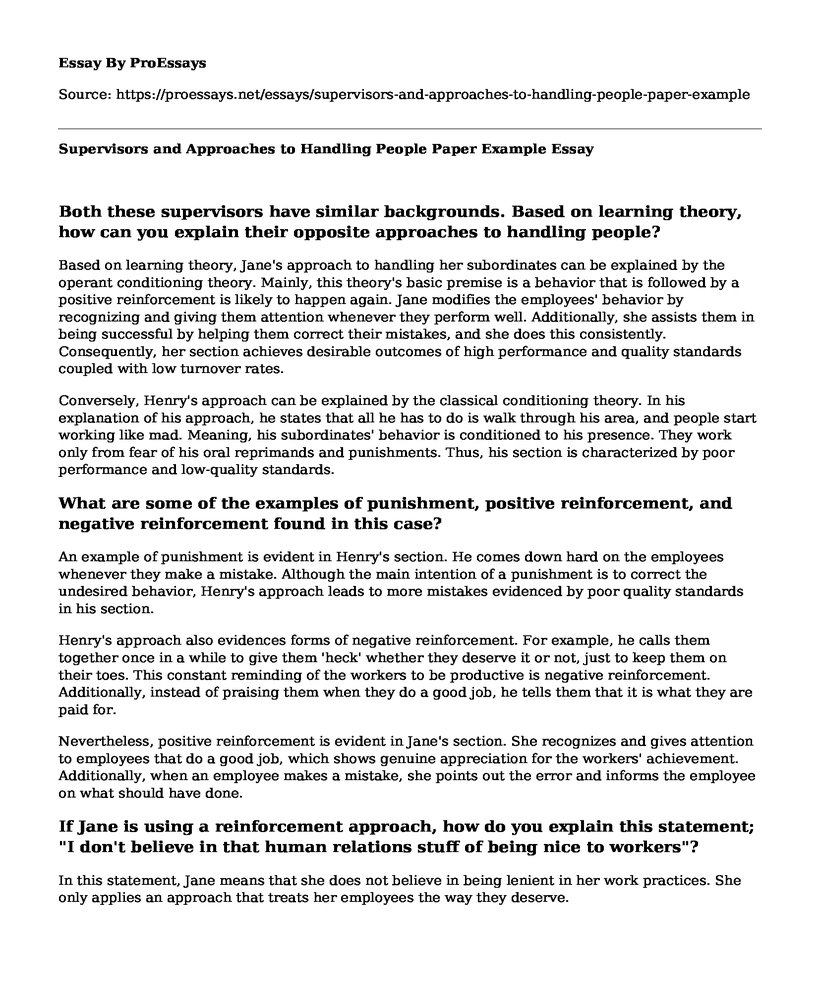Both these supervisors have similar backgrounds. Based on learning theory, how can you explain their opposite approaches to handling people?
Based on learning theory, Jane's approach to handling her subordinates can be explained by the operant conditioning theory. Mainly, this theory's basic premise is a behavior that is followed by a positive reinforcement is likely to happen again. Jane modifies the employees' behavior by recognizing and giving them attention whenever they perform well. Additionally, she assists them in being successful by helping them correct their mistakes, and she does this consistently. Consequently, her section achieves desirable outcomes of high performance and quality standards coupled with low turnover rates.
Conversely, Henry's approach can be explained by the classical conditioning theory. In his explanation of his approach, he states that all he has to do is walk through his area, and people start working like mad. Meaning, his subordinates' behavior is conditioned to his presence. They work only from fear of his oral reprimands and punishments. Thus, his section is characterized by poor performance and low-quality standards.
What are some of the examples of punishment, positive reinforcement, and negative reinforcement found in this case?
An example of punishment is evident in Henry's section. He comes down hard on the employees whenever they make a mistake. Although the main intention of a punishment is to correct the undesired behavior, Henry's approach leads to more mistakes evidenced by poor quality standards in his section.
Henry's approach also evidences forms of negative reinforcement. For example, he calls them together once in a while to give them 'heck' whether they deserve it or not, just to keep them on their toes. This constant reminding of the workers to be productive is negative reinforcement. Additionally, instead of praising them when they do a good job, he tells them that it is what they are paid for.
Nevertheless, positive reinforcement is evident in Jane's section. She recognizes and gives attention to employees that do a good job, which shows genuine appreciation for the workers' achievement. Additionally, when an employee makes a mistake, she points out the error and informs the employee on what should have done.
If Jane is using a reinforcement approach, how do you explain this statement; "I don't believe in that human relations stuff of being nice to workers"?
In this statement, Jane means that she does not believe in being lenient in her work practices. She only applies an approach that treats her employees the way they deserve.
How do you explain the performance, turnover, and quality results in these two sections of the production department?
The performance in both sections is high regarding the number of units produced. As the case study records, over the past several years, the two supervisors' sections have been head and shoulder above the other six sections on hard measures of performance. Nevertheless, while the performance at Jane's section results from motivated and satisfied employees, that in Henry's section results from fear of being reprimanded by the boss.
However, the rate of turnover is higher in Henry's section than in Jane's section. In particular, the records show that there has been three times more turnover in Henry's section than in Jane's section. The high turnover in Henry's section is attributable to his approach to handling workers, which is dictatorial in nature. In particular, he argues that the only way to handle workers is to come down hard on them. Conversely, the turnover rates are lower in Jane's section because she recognizes when her employees perform well and engage them when they commit mistakes to help them correct them.
Concerning the quality results, Jane's section has higher quality results than Henry's section. Moreover, according to the quality control records, Henry's section has met quality standards only twice in the last six years, while Jane's section has missed achieving quality standards only once in the last six years.
Cite this page
Supervisors and Approaches to Handling People Paper Example. (2022, Aug 17). Retrieved from https://proessays.net/essays/supervisors-and-approaches-to-handling-people-paper-example
If you are the original author of this essay and no longer wish to have it published on the ProEssays website, please click below to request its removal:
- Outcomes of Children Discharged from Mental Care Facilities
- Paper Example on Physical Therapy: An Important Well-Being Occupation
- Essay Sample on Maximizing Performance Through Focus, Passion & Inspiration
- Early Childhood Education: Assessing & Evaluating - Essay Sample
- College Student's Financial Struggle: Eating in Motels & Restaurants - Essay Sample
- Paper Example on Egan's Co. Should Invest in Recruiting Trainable Personnel for Long-Term Success
- Free Essay Sample on What College Life Means: Years of Experiences and Ideas







